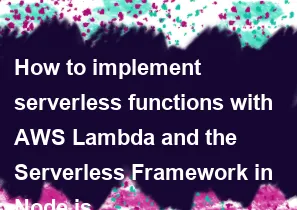How to implement serverless functions with AWS Lambda and the Serverless Framework in Node.js

Implementing serverless functions with AWS Lambda and the Serverless Framework in Node.js involves several steps. The Serverless Framework simplifies the deployment and management of serverless applications. Here's a step-by-step guide to help you get started:
Prerequisites:
Install Node.js and npm: Make sure you have Node.js and npm installed on your machine. You can download them from https://nodejs.org/.
Install Serverless Framework: Install the Serverless Framework globally using the following command:
bashnpm install -g serverlessAWS Account: You need an AWS account to create Lambda functions and other necessary resources.
Steps to Implement Serverless Functions:
1. Create a new Serverless project:
bashserverless create --template aws-nodejs --path my-serverless-project
cd my-serverless-project
This will create a basic Node.js project structure with a handler.js file.
2. Define your serverless function:
Edit the handler.js file to define your serverless function. For example:
javascript// handler.js
'use strict';
module.exports.hello = async (event) => {
return {
statusCode: 200,
body: JSON.stringify({
message: 'Hello, Serverless World!',
}),
};
};
3. Configure serverless.yml:
Edit the serverless.yml file to configure your Serverless project. Update the functions section with the details of your function:
yamlservice: my-serverless-project
provider:
name: aws
runtime: nodejs14.x
functions:
hello:
handler: handler.hello
events:
- http:
path: /
method: GET
4. Deploy your Serverless project:
Run the following command to deploy your Serverless project to AWS Lambda:
bashserverless deploy
5. Test your serverless function:
After the deployment, you will receive an endpoint URL. You can test your function using tools like curl or a web browser.
6. Update and Redeploy:
If you make changes to your code or configuration, you can redeploy the updated function using:
bashserverless deploy
Additional Tips:
- Use
serverless invoketo test your function locally. - Check the Serverless Framework documentation for more advanced configurations and features.
- Consider using environment variables for sensitive information.
- Monitor your AWS Lambda function using CloudWatch logs and metrics.
By following these steps, you can quickly create and deploy serverless functions with AWS Lambda and the Serverless Framework using Node.js.
-
Popular Post
- How to optimize for Google's About This Result feature for local businesses
- How to implement multi-language support in an Express.js application
- How to handle and optimize for changes in mobile search behavior
- How to handle CORS in a Node.js application
- How to use Vue.js with a UI framework (e.g., Vuetify, Element UI)
- How to configure Laravel Telescope for monitoring and profiling API requests
- How to create a command-line tool using the Commander.js library in Node.js
- How to implement code splitting in a React.js application
- How to use the AWS SDK for Node.js to interact with various AWS services
- How to use the Node.js Stream API for efficient data processing
- How to implement a cookie parser middleware in Node.js
- How to implement WebSockets for real-time communication in React
-
Latest Post
- How to implement a dynamic form with dynamic field styling based on user input in Next.js
- How to create a custom hook for handling user interactions with the browser's device motion in Next.js
- How to create a custom hook for handling user interactions with the browser's battery status in Next.js
- How to implement a dynamic form with dynamic field visibility based on user input in Next.js
- How to implement a dynamic form with real-time collaboration features in Next.js
- How to create a custom hook for handling user interactions with the browser's media devices in Next.js
- How to use the useSWRInfinite hook for paginating data with a custom loading indicator in Next.js
- How to create a custom hook for handling user interactions with the browser's network status in Next.js
- How to create a custom hook for handling user interactions with the browser's location in Next.js
- How to implement a dynamic form with multi-language support in Next.js
- How to create a custom hook for handling user interactions with the browser's ambient light sensor in Next.js
- How to use the useHover hook for creating interactive image zoom effects in Next.js